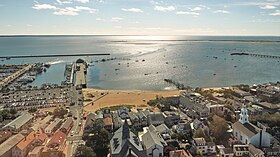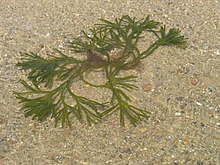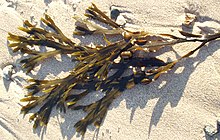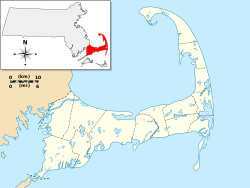Provincetown Harbor
| Provincetown Harbor | |
|---|---|
 Provincetown Harbor, looking south-east from Pilgrim Monument | |
 | |
| Location | |
| Country | United States |
| Location | Provincetown, Massachusetts |
| Coordinates | 42°02′41″N 70°10′13″W / 42.044593°N 70.170244°W |
Provincetown Harbor is a large natural harbor located in the town of Provincetown, Massachusetts. The harbor is mostly 30 to 90 feet (9 to 27 m) deep and stretches roughly 1 mile (1.6 km) from northwest to southeast and 2 miles (3.2 km) from northeast to southwest – one large, deep basin with no dredged channel necessary for boats to enter and exit.
A tall green buoy east of Long Point (i.e., the tip of Cape Cod) marks the entrance to Provincetown Harbor from Cape Cod Bay.
Geology

Most of Cape Cod was created by the Laurentide Glacier between 18,000 and 15,000 years ago. However, the Provincetown Spit, i.e., the land surrounding Provincetown Harbor from High Head in North Truro through all of Provincetown, consists largely of marine deposits transported from farther up the shore during the last 6,000 years.[1]
History
A stone wall
"Cape Cod... is only a headland of high hills of sand, overgrown with shrubby pines, hurts, and such trash, but an excellent harbor for all weathers. This Cape is made by the main sea on the one side, and a great bay on the other, in form of a sickle..."[6]
Pilgrims' first landing

Provincetown Harbor was the initial anchoring place of the
"a good harbor and pleasant bay, circled round, except in the entrance, which is about four miles (6 km) over from land to land, compassed about to the very sea with oaks, pines, juniper, sassafras, and other sweet wood; it is a harbor wherein 1000 sail of ships may safely ride, there we relieved ourselves with wood and water, and refreshed our people, while our shallop was fitted to coast the bay, to search for an habitation: there was the greatest store of fowl we ever saw."[8]
The Mayflower held several different
Village of Long Point

From 1818 until the 1850s a fishing village existed at
During the
Today, Long Point is a

East Harbor
For the better part of modern history, the eastern part of Provincetown harbor was connected to yet another harbor, historically known as East Harbor. East Harbor was the most protected mooring place in the outer Cape for boats using Cape Cod Bay and the Gulf of Maine. East Harbor had a 1,000-foot-wide (305 m) inlet from Provincetown Harbor, as shown in the adjacent map from 1836.[16]
Until the late 19th century, there was not a single road leading in or out of Provincetown – the only land route connecting Provincetown to points beyond was along a thin stretch of beach along the shore to the north (locally called the "backshore"). A wooden bridge was erected over the East Harbor in 1854, only to be destroyed by a winter storm and ice two years later.[18] Although the bridge was replaced the following year, a traveler using it still had to traverse several miles over a sand route, which, along with the backshore route, would occasionally be washed out by storms. This made Provincetown much like an island, in that it relied almost entirely upon its harbor for its communication, travel, and commerce needs.[19]
In 1868 the mouth of the East Harbor was
In the ensuing years, the
Other history
The Portland gale of 1898 destroyed several wharves and fishing vessels within the harbor.
In 2002, Provincetown Harbor Beach was selected by the US Environmental Protection Agency as one of three Flagship beaches for the state of Massachusetts that serve as models for beach managers in water quality monitoring and pollution assessments and because of its health.
The harbor is the southern boundary of the
Landmarks
Two main parallel wharves dominated the center of the harbor in the late 19th century: Railroad Wharf and Steamboat Wharf. President Grant visited Provincetown for the opening of the railroad in 1874.[23] Today, the wharves have been replaced by piers. Although rail and steamboat service to Provincetown both ended long ago, ferry service continues.
MacMillan Pier, the town pier of Provincetown, was significantly renovated and expanded during 2003-2005 with the help of a $1.95 million low interest
Immediately parallel to MacMillan Pier is Fisherman's Wharf, also known to locals as Cabral's Pier.[29] They Also Faced the Sea is an outdoor art installation of five large portraits of local Portuguese-American women photographed by Norma Holt hanging since 2003 on one side and one end of the old fish-packing plant on Cabral Pier.[30]
In both 1907 and 1910, when the Pilgrim Monument began construction and when it was dedicated, the entire Atlantic fleet of the U.S. Navy was inside the harbor for large ceremonies led by Presidents Theodore Roosevelt and William Howard Taft, respectively.
In addition to a panoramic view of the whole town, the harbor affords views of three working
On the East End of Provincetown, Lewis Wharf was purchased by Mary Heaton Vorse, and its old fish shack converted into a theater which became the home of the Provincetown Players. Eugene O'Neill debuted his first play, Bound East for Cardiff, there in 1916.[31]
Captain Jack's Wharf is on the West End of Provincetown. At another theater on that wharf,
The West End Breakwater, built in 1911 by the
Marine life
Provincetown Harbor supports a wide variety of
The harbor is an amazingly diverse and productive habitat. The following tables list in no particular order 94 examples of marine life that are regularly observed within the harbor. A few landbirds are included that are common around MacMillan Pier, on the beaches, and on the breakwater.


| Seaweeds |
|---|
| Ulva (sea lettuce) |
| Irish moss (Chondrus crispus) |
| Pylaiella (mung) |
bladder wrack
|
knotted wrack
|
| codium fragile (dead man's fingers) |


| Crustaceans, chelicerates, molluscs | Other invertebrates |
|---|---|
| American lobster | orange-footed sea cucumber
|
rock crab |
Forbes' sea star |
| jonah crab | Atlantic purple sea urchin |
portly spider crab |
ctenophore (comb jelly)
|
calico crab (lady crab) |
moon jelly |
| green crab | various sea sponges
|
Japanese shore crab |
clam worm
|
| long-clawed hermit crab | northern red anemone
|
flat-clawed hermit crab |
stalked sea squirt |
| copepod | sea grape |
| gammarid amphipod (sideswimmer) | Didemnum sp. |
isopod |
chain tunicates |
| barnacle | golden star tunicates |
skeleton shrimp |
lacy crusted bryozoa |
| Atlantic horseshoe crab | tubeworm |
| longfin inshore squid | brittle-star
|
common slipper shell |
salp |
| quahog (hard clam) | spiral tufted bryozoa |
| soft-shell clam (steamer) | snail fur |
| Atlantic bay scallop | tubularian hydroids |
| Eastern oyster (American oyster) | sinistral spiral tubeworm |
| common periwinkle | featherduster worm |
northern moon snail |
ice cream cone worm |
| oyster drill | |
Eastern mudsnail |
|
| blue mussel |



| Fish | Birds | Marine mammals |
|---|---|---|
| flounder (fluke) | American herring gull | Atlantic white-sided dolphin |
| striped bass | great black-backed gull | harbor porpoise
|
| bluefish | double-crested cormorant | harbor seal |
| Atlantic mackerel | great cormorant | grey seal |
| spiny dogfish | common eider | North Atlantic right whale |
| tautog | rock pigeon |
humpback whale |
cunner (bergall) |
house sparrow | Minke whale |
| pipefish | black-crowned night-heron |
fin whale |
lumpfish (lumpsucker) |
great blue heron | |
| American eel | green heron | |
cusk eel |
ruddy turnstone | |
| Atlantic herring | northern gannet | |
| three-spined stickleback | Wilson's storm-petrel
| |
| black sea bass | laughing gull | |
| little skate | ring-billed gull | |
| basking shark | common tern | |
| Atlantic bluefin tuna | least tern | |
| sculpin | American crow | |
| sand lance | sanderling | |
| scup (porgy) | great shearwater | |
ling cod |
||
| ocean sunfish[dubious ] |
Historic annual events
The Great Provincetown Schooner Regatta each September preserves the harbor's history as a great sailing port.
A Blessing of the Fleet ceremony is held at the end of MacMillan Pier in late June, when all the boats operating in the harbor are blessed by a visiting bishop as part of the Provincetown Portuguese Festival.
The Swim for Life occurs each September since 1988, which is a swim across the harbor to raise funds and awareness of HIV/AIDS, women's health and community health.
Commercial use

Roughly a dozen
, several different sportfishing boats, boat rentals, and other commercial boats also use the harbor today.East Coast whale watching on Stellwagen Bank originated as a joint effort of the Dolphin Fleet and the Center for Coastal Studies leaving from MacMillan Pier in 1975.[citation needed] In addition, other tour boat operators offer a variety of tours of and from the harbor, including historical sightseeing tours, harbor marine life tours, sunset cruises and more.
Further reading and other information
- Wikipedia List of Nationally Registered Historic Places in Provincetown
- Oldale, R. N., 1992, Cape Cod and the Islands, the geologic story: Parnassus Imprints, East Orleans, Massachusetts, 208 p. see Geologic History of Cape Cod, Massachusetts
- Carl Christian Rafn, 1837. Antiquitates Americanæ. referred to by The Norse Wall House
- Strahler, A. N., 1966, A Geologist's View of Cape Cod: Doubleday. Reprinted Parnassus Imprints (1988), Orleans, Massachusetts, 115 p.
- Vorse, M.H. Time and the Town: A Provincetown Chronicle. 1942. Dial Press, New York, 372 p.
- a Norma Holt exhibit in "Faces & Places"
- "Shutterbug" 1999 interview with Norma Holt
- Things to Do compiled by Provincetown Public Pier Corporation
- Provincetown Chamber of Commerce has information about annual events, plus tourist information such as cruises and tours of the harbor.
- old postcard of Captain Jack's wharf in West End
External links
- WikiMapia aerial view showing several landmarks
References
- ^ "NPS: Nature & Science, Geology Resources Division". Archived from the original on 2007-02-09. Retrieved 2007-02-13.
- ^ "The Norse Wall House on Wikimapia". Retrieved 2007-02-13.
- ^ "The Norse Wall". capelinks.com. Retrieved 2007-02-13.
- ^ "The Visiting Vikings". Retrieved 2007-02-13.
- ^ Archer, Gabriel (1912). Ed. Frances Healey (ed.). GREAT EPOCHS IN AMERICAN HISTORY: The Relation of Captain Gosnold's Voyage. Funk & Wagnalls Co. p. 38.
- ^ Smith, John; Paul Royster (2006). A Description of New England: An Online Electronic Text Edition. University of Nebraska - Lincoln: Digital Commons. p. 23.
- ISBN 0-940450-27-5.
- ^ Winslow, Edward; William Bradford (1622). A Relation or Journal of the Beginning and Proceeding of the English Plantation Settled at Plymouth (PDF). London, England: John Bellamie. p. 6. Archived from the original (PDF) on 2008-10-29.
- ISBN 0-8048-7024-1.
shebnah rich history of truro.
- ISBN 0-665-44870-8.
- ISBN 0-87013-411-6.
- ^ Provincetown Historical Association. "Walking Tour#1, The Center of Provincetown". Pilgrim Monument and Provincetown Museum. Archived from the original on 2006-12-09. Retrieved 2007-02-10.
- ^ Jennings, Herman A. (1890). Provincetown or Odds and Ends From the Tip End. Peaked Hill Press. pp. 78–79.
- US Army Corps of Engineers. January 1997. Archived from the original(PDF) on 8 March 2004. Retrieved 25 May 2012.
- ISBN 9780609609071. Retrieved 15 May 2012.
... as volunteers stood guard day after day and night after night over an uncontested stretch of salt water, the fortresses came to be known as Fort Useless and Fort Ridiculous.
- ^ Bureau of U.S. Topographical Engineers. 1836. Retrieved 2 June 2012.
- ^ a b Massachusetts: Provincetown Sheet (Map). 1 : 62,500. Cartography by Henry Gannett (Chief Geographer) and Marcus Baker (Geographer-in-Charge). United States Geological Survey. July 1889 [Surveyed 1887]. Archived from the original (PDF) on 8 April 2013. Retrieved 23 May 2012.
- ^ a b Jennings (1890), p. 197.
- ^ Theriault, Wor. James J. "The Railroad Comes To Provincetown". King Hirams's Lodge of Ancient Free and Accepted Masons. Archived from the original on 4 April 2016. Retrieved 2 May 2012.
- ^ a b Lum, Kaimi Rose (20 June 2008). "East Harbor gets its name back". Provincetown Banner.
- ^ Peter Schworm (August 9, 2004). "In Truro, a dying lake now overflows with life". Boston Globe.
- ^ John Portnoy; et al. (2006). "East Harbor 2006 Annual Report" (PDF). Cape Cod National Seashore. Archived from the original (PDF) on 2007-06-27. Retrieved 2007-02-12.
- ^ Deyo, Simeon L. (1890). History of Barnstable County. New York: H. W. Blake & Co. p. 971.
- ^ Gaul, Gilbert M.; Cohen, Sarah (2007-04-06). "Rural Aid Goes to Urban Areas: USDA Development Program Helps Suburbs, Resort Cities". The Washington Post. Retrieved 2010-05-22.
- ^ Boston-Provincetown ferry Retrieved on April 5, 2007
- ^ Plymouth-Provincetown ferry Archived 2007-04-12 at the Wayback Machine Retrieved on April 5, 2007
- ^ Provincetown Public Pier Corporation
- ^ "MacMillan Pier Lease Agreement". Town of Provincetown. 2005. Retrieved 2007-02-13.
- ^ Sowers, Pru (2005). "Town backs Cabral Pier parking & mooring". Provincetown Banner. Aug. 25.
- ^ Nogiec, Ewa. ""They Also Faced the Sea" - Art Installation". iamprovincetown.com. Retrieved 2007-03-02.
- ^ Bound East for Cardiff, there in 1916
- ^ Station Provincetown
- ^ "USCG Sta Provincetown History page". USCG. Retrieved 2007-02-26.
- ^ West End Breakwater
- ^ Laurel Guadazno (2006). "History Highlights: Dikes and Breakwaters". Pilgrim Monument and Provincetown Museum. Archived from the original on December 9, 2006. Retrieved 2007-02-12.

